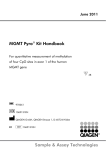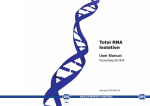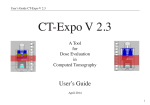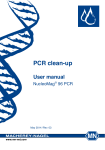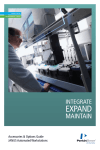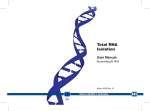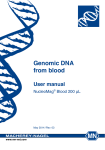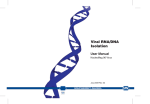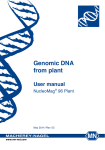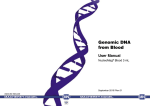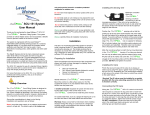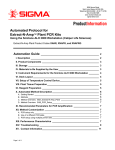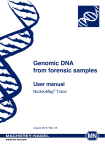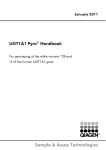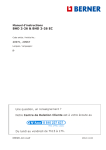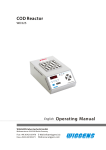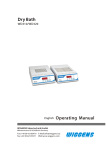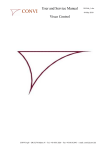Download NucleoMag® 96 Blood
Transcript
Genomic DNA from Blood User manual NucleoMag 96 Blood February 2003/Rev. 01 www.mn-net.com MACHEREY-NAGEL MN TÜV CERT DIN EN ISO 9001.2000 Certificate: 01 100 5507 MACHEREY-NAGEL MN Genomic DNA from Blood Table of contents 1 Kit contents 4 2 Product description 5 2.1 The basic principle 5 2.2 Kit specifications 6 2.3 Magnetic separation systems 6 2.4 Adjusting the shaker settings 7 2.5 Handling of beads 7 2.6 Elution procedures 8 3 Storage conditions and preparation of working solutions 4 General procedure 4.1 Standard protocol for the purification of genomic DNA 5 Appendix 9 10 12 14 5.1 Troubleshooting 14 5.2 Ordering information 16 6.4 Product Use Restriction / Warranty 16 MACHEREY-NAGEL – 02/2003/Rev.01 3 Genomic DNA from Blood 1 Kit contents NucleoMag 96 Blood 1 x 96 preps 4 x 96 preps 24 x 96 preps 744 500.1 744 500.4 744 500.24 1.68 ml 6.7 ml 40.3 ml Lysis Buffer MB1 15 ml 60 ml 360 ml Binding Buffer MB2 40 ml 2 x 80 ml 8 x 120 ml Wash Buffer MB3 66 ml 264 ml 2 x 792 ml Wash Buffer MB4 66 ml 264 ml 2 x 792 ml Wash Buffer MB5 102 ml 408 ml 3 x 816 ml Elution Buffer MB6 12 ml 48 ml 288 ml Elution plate, U-bottom (including one Selfadhering PE foil) 1 4 24 Protocol 1 1 1 Cat. No. NucleoMag B-Beads Material to be supplied by user: Separation plate, e.g. MN Square-well Block (see ordering information). 4 MACHEREY-NAGEL – 02/2003/Rev.01 Genomic DNA from Blood 2 Product description 2.1 The basic principle The NucleoMag 96 Blood procedure is based on reversible adsorption of nucleic acids to paramagnetic beads under appropriate buffer conditions. Whole blood is lysed with Lysis Buffer MB1 without a proteinase K digestion. Adjusting the binding conditions of nucleic acid with Binding Buffer MB2 and addition of paramagnetic beads can be carried out simultaneously. After magnetic separation and removal of supernatant the paramagnetic beads are washed three times to remove contaminants and salt. There is no need for a drying step as ethanol from previous wash steps is removed by Wash Buffer MB5. Finally, highly purified DNA is eluted with low-salt Elution Buffer MB6 and can directly be used for downstream applications. The NucleoMag 96 Blood kit can be used either manually or automated on standard liquid handling instruments. Whole blood is lysed with Lysis Buffer MB1. Binding conditions are adjusted and the NucleoMag Blood Beads are added to the sample. DNA is bound to the NucleoMag Blood Beads. Beads are held back in the well while contaminants are washed away. DNA is eluted from the beads and recovered, while beads are held back in the well by the magnet. DNA is ready-to-use in downstream applications. MACHEREY-NAGEL – 02/2003/Rev.01 5 Genomic DNA from Blood 2.2 Kit specifications NucleoMag 96 Blood is designed for rapid manual and automated small-scale preparation of highly pure genomic DNA from whole blood using the NucleoMag 96 SEP (see ordering information) or other magnetic separation systems (see section 2.3). Manual time for the preparation of 96 samples is about 120 minutes. The obtained DNA can be used directly as template for PCR, blotting, or any kind of enzymatic reactions. NucleoMag 96 Blood allows easy automation on common liquid handling instruments. The actual processing time depends on the configuration of your instrument and the magnetic separation system used. Typically, 96 samples can be purified in less than 120 minutes using the NucleoMag SEP on the automation platform. The kit provides reagents for the purification of 1 – 4 µg of pure genomic DNA from 100 µl whole blood with an A260/280 ratio ≥ 1.6 – 1.9 and typical concentration of 20 – 40 ng/µl. Depending on health status of the donor and the elution volume used concentrations of 10 – 160 ng/µl can be obtained. Fresh, frozen or blood treated either with EDTA, citrate, or heparin can be used. The procedure is optimized for a sample volume of 100 µl. NucleoMag 96 Blood can be processed completely at room temperature. Elution at 55oC will increase the yield by about 15 – 20%. NucleoMag Blood Beads are highly reactive, superparamagnetic beads. The binding capacity is 0.4 µg of gDNA per 1 µl of NucleoMag Blood-Bead Suspension, 1 µl of suspension contains 130 µg of beads. 2.3 Magnetic separation systems For use of NucleoMag 96 Blood the NucleoMag SEP is recommended. Separation is carried out in a MN Square-well Block (see ordering information). The kit can also be used with other common separators. See suppliers ordering information for suitable separation plates. Magnetic separator NucleoMag SEP (Cat. No. 744 900) Promega MagnaBot Tecan Te-MagS Separation plate or tube Square-well Block (MN, Cat. No. 740 670) Square-well Block (MN, Cat. No. 740 670) 1.5 ml tubes without lid (Sarstedt) Static magnetic pins Separators with static magnetic pins, e.g. NucleoMag SEP (for manual use and for use on liquid handling workstations): This type of separator is recommended in combination with a plate shaker, e.g. H+P Variomag® Teleshake (H+P Labortechnik AG, Bruckmannring 28, D-85764 Oberschleißheim, Germany, www.hp-lab.de), for optimal resuspension of the beads during the washing and elution steps. Alternatively, beads can be resuspended in the buffer by pipetting up and down several times. For fully-automated use on liquid handling workstations a gripper tool 6 MACHEREY-NAGEL – 02/2003/Rev.01 Genomic DNA from Blood is required, the plate is transferred to the magnetic separator for separation of the beads and transferred to the shaker module for resuspension of the beads. Movable magnetic systems Separators with moving magnetic pins, e.g. Te-MagS (for automated use only): Magnetic pins/rods are moved from one side of the well to the other and vice versa. Beads follow this movement and are thus pulled through the buffer during the wash and elution steps. Separation takes place when the system stops. 2.4 Adjusting the shaker settings When using a plate shaker for the washing and elution steps the speed settings have to be checked carefully for each specific separation plate and shaker to prevent cross-contamination from well to well. Proceed as follows: • Apply 600 µl dyed water (select desired elution buffer volume) to the wells of the separation plate. Position the plate on the shaker and start shaking with a moderate speed setting for 30 seconds. Turn off the shaker and check plate surface for small droplets of dyed water. • Increase speed setting, shake for an additional 30 seconds, and check plate surface for droplets again. • Continue increasing the speed setting until you observe droplets on top of the separation plate. Reduce speed setting, check again and use this setting for the washing and elution step. 2.5 Handling of beads Distribution of beads A homogenous distribution of the magnetic beads to the individual wells of the separation plate is essential for a high well-to-well consistency. Therefore, before distributing the beads make sure that the beads are completely resuspended. Shake the storage bottle well or place it on a vortex shortly. Premixing magnetic beads with the binding buffer allows easier homogenous distribution of the beads to the individual wells of the separation plate. During automation, a premix step before aspirating the beads/binding buffer mixture from the reservoir is recommended to keep the beads resuspended. Magnetic separation time Attraction of the magnetic beads to the magnetic pins depends on the magnetic strength of the magnetic pins, the selected separation plate, distance of the separation plate from the magnetic pins, and the volume to be processed. The individual times for complete attraction of the beads to the magnetic pins should be checked on each system. It is recommended to use the separation plates or tubes specified by the supplier of the magnetic separator. Washing the beads Washing the beads can be achieved by shaking or mixing. In contrast to mixing by pipetting up and down mixing by shaker or magnetic mixing allows simultaneous mixing of all samples. This reduces the time and number of tips needed for the preparation. Resuspension by pipetting up and down is more efficient than mixing by a shaker or magnetic mix. MACHEREY-NAGEL – 02/2003/Rev.01 7 Genomic DNA from Blood Method Resuspension Efficiency + ++ +++ Magnetic mix Shaker Pipetting Speed ++ ++ +* Small elution volume possible + +++ ++ Number of tips needed Low Low High * 8-channel pipetting device 2.6 Elution procedures Purified genomic DNA can be eluted directly with the supplied Elution Buffer MB6. Elution can be carried out in a volume of ≥ 25 µl. It is essential to cover the NucleoMag Blood Beads completely with elution buffer during the elution step. The volume of dispensed elution buffer depends on the magnetic separation system (the position of the pellet inside the separation plate). For efficient elution the magnetic bead pellet should be resuspended completely in the elution buffer. For some separators high elution volumes might be necessary to cover the whole pellet. 5 Yield does not depend on elution volume. Averages of 8 samples per elution volume are shown. Yield (µg) 4 3 2 1 0 0 25 50 75 100 125 150 175 200 Elution Volume (µl) 5 Yield (µg) 4 3 room temperature 2 55 degrees C 1 0 1 2 3 4 5 6 7 8 Sample Number Elution is possible at room temperature. Yield can be increased by 15 – 20% if elution is performed at 55oC. 8 MACHEREY-NAGEL – 02/2003/Rev.01 Genomic DNA from Blood 3 Storage conditions and preparation of working solutions Attention: Buffers MB1, MB2, MB3, and MB4 contain chaotropic salt! Wear gloves and goggles! Upon storage, especially at low temperatures, a white precipitate may form in buffer MB3. Dissolve such precipitates by incubation of the bottle at 37°C before use. All components of the NucleoMag 96 Blood kit should be stored at room temperature (20-25°C) and are stable for up to one year. All buffers are delivered ready-to-use. MACHEREY-NAGEL – 02/2003/Rev.01 9 NucleoMag 96 Blood 4 1 General procedure Transfer blood to Square-well Block. 100 µl Blood 2 Lyse cells. 125 µl MB1 shake 5 min, RT 3 Bind DNA to NucleoMag Blood Beads. 14 µl B-Beads 360 µl MB2 shake 5 min, RT 4 Remove supernatant. 2 min separation 5 MB3 wash step. 600 µl MB3 shake 5 min, RT 2 min separation 10 MACHEREY-NAGEL – 02/2003/Rev.01 NucleoMag 96 Blood 6 MB4 wash step. 600 µl MB4 shake 5 min, RT 2 min separation 7 MB5 wash step. 600 µl MB5 90 sec incubation 2 min separation 8 Elute genomic DNA and transfer to Elution Plate. 25 – 100 µl MB6 shake 5 min, RT 2 min separation transfer Optional: Elution at 55oC MACHEREY-NAGEL – 02/2003/Rev.01 11 NucleoMag 96 Blood 4.1 Standard protocol for the purification of genomic DNA This protocol is designed for magnetic separators with static pins (e.g. NucleoMag SEP) and suitable plate shakers (e.g. H+P Variomag® Teleshake). This protocol is for manual use and serves as a guideline for adapting the kit to robotic instruments. For the availability of ready-to-run scripts please contact your local distributor or MN directly. 1 Transfer 100 µl blood (equilibrated to room temperature) to a Square-well Block. Do not moisten the rims of the well. Note: See recommendations for suitable plates or tubes and compatible magnetic separators section 2.3. 2 Add 125 µl Lysis Buffer MB1 to each sample and mix by shaking (5 min) at room temperature. Alternatively, pipette up and down 10 times and incubate 5 min at room temperature. 3 For 96 samples mix at least 1344 µl of NucleoMag B-Beads with 34.56 ml of buffer MB2, vortex briefly and add 374 µl of this mixture to each well of the Square-well Block. Mix immediately by shaking (5 min) at room temperature. Alternatively, pipette up and down 10 times and incubate 5 min at room temperature. Note: NucleoMag B-Beads and Binding Buffer MB2 should be premixed. Per well to be processed mix 14 µl of NucleoMag B-Beads with 360 µl Binding Buffer MB2. Vortex briefly. Depending on the dead volume of the reservoir, additional amounts of bead suspension and binding buffer are necessary. Be sure to resuspend the NucleoMag B-Beads before removing them from the storage bottle. Vortex storage bottle briefly until a homogenous suspension has formed. 4 Separate the magnetic beads against the side of the wells by placing the Squarewell Block on the magnetic separator. Wait at least 2 min until all the beads have been attracted to the magnet. Remove and discard supernatant by pipetting. Remove the Square-well Block from the magnetic separator. Note: Do not disturb the attracted beads while aspirating the supernatant. The magnetic pellet is not visible in this step. Remove supernatant from the opposite side of the well. 12 MACHEREY-NAGEL – 02/2003/Rev.01 NucleoMag 96 Blood 5 Add 600 µl Wash Buffer MB3 to each well and wash the bead/DNA complex by shaking (5 min) at room temperature. Alternatively, pipette up and down 15 times. Separate all of the magnetic beads against the side of the well by placing the Square-well Block on the magnetic separator. Aspirate and discard the supernatant. Remove the Square-well Block from the magnetic separator. Note: Supernatant has a brownish color, magnetic bead pellet is visible now. 6 Add 600 µl Wash Buffer MB4 to each well and wash the bead/DNA complex by shaking (5 min) at room temperature. Alternatively, pipette up and down 15 times. Separate all of the magnetic beads against the side of the well by placing the Square-well Block on the magnetic separator. Aspirate and discard the supernatant. Do not remove the Square-well Block from the magnetic separator. Note: Supernatant is colorless, magnetic bead pellet is clearly visible. 7 Add 800 µl Wash Buffer MB5 to each well and incubate for 90 s while the beads are still separated on the magnet. Then aspirate and discard the supernatant. Note: Do not resuspend the beads in Wash Buffer MB 5. This step is to remove traces of ethanol and eliminates a drying step. 8 Add desired volume of Elution Buffer MB6 (25 – 100 µl) to each well and resuspend the bead/DNA complex by shaking (5 – 10 min). Alternatively, pipette up and down 10 times and incubate 5 – 10 min. Separate the magnetic beads against the side of the wells by placing the Squarewell Block on the magnetic separator. Wait 2 min until all the beads have been attracted to the magnet. Transfer the supernatant containing the purified genomic DNA to the Elution Plate. Note: The yield can be increased by 15 – 20% by using prewarmed elution buffer (55°C) or by incubating the bead/elution buffer suspension at 55°C for 10 min. MACHEREY-NAGEL – 02/2003/Rev.01 13 Genomic DNA from Blood 5 Appendix 5.1 Troubleshooting Problem Possible cause and suggestions Elution buffer volume insufficient • Beads pellet must be covered completely with elution buffer Insufficient performance of elution buffer during elution step • Remove residual buffers during the separation steps completely. Remaining buffers decrease efficiency of following wash steps and elution step. Beads dried out • Do not let the beads dry as this might result in lower elution efficiencies. Partial elution in Wash Buffer MB5 already Poor DNA yield • Keep the beads on the magnet while dispensing Wash Buffer MB5. Do not resuspend beads in this buffer, and do not incubate beads in this buffer for more than 2 min, as this buffer is water-based and might elute the DNA already. Aspiration of attracted bead pellet • Do not disturb the attracted beads while aspirating the supernatant, especially when the magnetic pellet is not visible in the lysate. Incubation after dispensing beads to lysate • Mix immediately after dispensing NucleoMag BBeads/Binding Buffer MB2 to the lysate. Poor blood quality • Low purity Insufficient washing procedure • 14 Be sure that no blood clots are transferred to the well. Blood can be stored at 2 – 8°C for two weeks. Freeze samples if stored for longer periods. Use only the appropriate combinations of separator and plate, e.g. MN Square-well Block in combination with NucleoMag SEP. MACHEREY-NAGEL – 02/2003/Rev.01 Genomic DNA from Blood Problem Possible cause and suggestions Carry-over of ethanol from wash buffer MB4 Suboptimal performance of DNA in downstream applications • Be sure to remove all of the ethanolic Wash Buffer MB4, as residual ethanol interferes with downstream applications. Low purity • see above Time for magnetic separation too short • Carry-over of beads Increase separation time to allow the beads to be completely attracted to the magnetic pins before aspirating any liquid from the well. Aspiration speed too high (elution step) • High aspiration speed during the elution step may cause bead carry over. Reduce aspiration speed for elution step. Contamination of the rims Cross contamination • Do not moisten the rims of the Square-well Block when transferring the blood. If the rim of the wells is contaminated, seal the Square-well Block with selfadhering PE foil (see ordering information) before starting the shaker. MACHEREY-NAGEL – 02/2003/Rev.01 15 Genomic DNA from Blood 5.2 Ordering information Product Cat. No. Pack of NucleoMag 96 Blood 744 500.1 1 x 96 NucleoMag 96 Blood 744 500.4 4 x 96 NucleoMag 96 Blood 744 500.24 24 x 96 NucleoMag SEP 744 900 1 Square-well Blocks 740 670 20 Self-adhering PE foil 740 676 50 sheets 6.4 Product Use Restriction / Warranty NucleoMag 96 Blood kit components were developed, designed and sold for research purposes only. They are suitable for in vitro uses only. No claim or representation is intended for its use to identify any specific organism or for clinical use (diagnostic, prognostic, therapeutic, or blood banking). It is rather the responsibility of the user to verify the use of the NucleoMag 96 Blood kit for a specific application range as the performance characteristic of this kit has not been verified to a specific organism. This MACHEREY-NAGEL product is shipped with documentation stating specifications and other technical information. MACHEREY-NAGEL warrants to meet the stated specifications. MACHEREY-NAGEL´s sole obligation and the customer´s sole remedy is limited to replacement of products free of charge in the event products fail to perform as warranted. Supplementary reference is made to the general business terms and conditions of MACHEREY-NAGEL, which are printed on the price list. Please contact us if you wish an extra copy. MACHEREY-NAGEL does not warrant against damages or defects arising in shipping and handling (transport insurance for customers excluded), or out of accident or improper or abnormal use of this product; against defects in products or components not manufactured by MACHEREY-NAGEL, or against damages resulting from such non-MACHEREY-NAGEL components or products. MACHEREY-NAGEL makes no other warranty of any kind whatsoever, and SPECIFICALLY DISCLAIMS AND EXCLUDES ALL OTHER WARRANTIES OF ANY KIND OR NATURE WHATSOEVER, DIRECTLY OR INDIRECTLY, EXPRESS OR IMPLIED, INCLUDING, WITHOUT LIMITATION, AS TO THE SUITABILITY, REPRODUCTIVITY, DURABILITY, FITNESS FOR A PARTICULAR PURPOSE OR USE, MERCHANTABILITY, CONDITION, OR ANY OTHER MATTER WITH RESPECT TO MACHEREY-NAGEL PRODUCTS. 16 MACHEREY-NAGEL – 02/2003/Rev.01 Genomic DNA from Blood In no event shall MACHEREY-NAGEL be liable for claims for any other damages, whether direct, indirect, incidental, compensatory, foreseeable, consequential, or special (including but not limited to loss of use, revenue or profit), whether based upon warranty, contract, tort (including negligence) or strict liability arising in connection with the sale or the failure of MACHEREY-NAGEL products to perform in accordance with the stated specifications. This warranty is exclusive and MACHEREY-NAGEL makes no other warranty expressed or implied. The warranty provided herein and the data, specifications and descriptions of this MACHEREY-NAGEL product appearing in MACHEREY-NAGEL published catalogues and product literature are MACHEREY-NAGEL´s sole representations concerning the product and warranty. No other statements or representations, written or oral, by MACHEREY-NAGEL´s employees, agent or representatives, except written statements signed by a duly authorized officer of MACHEREY-NAGEL are authorized; they should not be relied upon by the customer and are not a part of the contract of sale or of this warranty. Product claims are subject to change. Therefore please contact our Technical Service Team for the most up-to-date information on MACHEREY-NAGEL products. You may also contact your local distributor for general scientific information. Applications mentioned in MACHEREY-NAGEL literature are provided for informational purposes only. MACHEREY-NAGEL does not warrant that all applications have been tested in MACHEREY-NAGEL laboratories using MACHEREY-NAGEL products. MACHEREY-NAGEL does not warrant the correctness of any of those applications. Please contact: MACHEREY-NAGEL Germany Tel.: +49-2421/969 270 and 275 e-mail: [email protected] MACHEREY-NAGEL – 02/2003/Rev.01 17

















